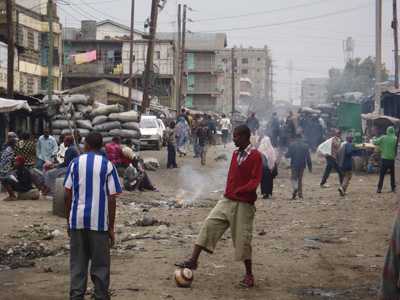Africa Field Program
CDC’s Division of Global Migration and Quarantine (DGMQ), assisted by the Division of Global Health Protection, sponsors the Africa Field Program, administered from CDC’s Kenya office, which is dedicated to the improvement and promotion of health for refugees and immigrants. The DGMQ Africa Field Program’s major partners in this effort are the Kenya Medical Research Institute, International Organization for Migration, and UN High Commissioner for Refugees.
Core Activities
Refugees in Africa
- 2.7 million people with refugee or “refugee-like” status in Africa at the end of 2011
- 770,000 refugees in Kenya
- 376,000 refugees in Ethiopia
- Coordinates activities to protect the health of refugees who resettle to the US
- Conducts disease surveillance
- Provides technical training and support
- Builds capacity for healthcare partners
- Strengthens international partnerships
- Responds to outbreaks in Africa
Dadaab and Kakuma Refugee Camps
Dadaab
450,000 refugees primarily from Somalia
Kakuma
120,000 refugees primarily from Somalia, Ethiopia, and South Sudan
Not far from the Somali border of Kenya lies the town of Dadaab, home to over 450,000 refugees in what is the largest refugee camp in the world. The Kakuma camp is closer to the border with Sudan, and has over 120,000 refugees. Refugees at both camps are faced with a host of medical problems which are compounded by the overcrowded conditions and limited access to care. Infectious diseases spread quickly in such conditions. Each year, the United States receives about 4,000 refugees from the Dadaab and Kakuma refugee camps, so DGMQ focuses primarily on improving health of refugees from these locations.
The camps are administered by the United Nations High Commissioner for Refugees (UNHCR), assisted by a range of non-governmental organizations that provide shelter, food, healthcare, water and sanitation, and other services.
Role in Resettling African Refugees to the United States

Women carrying water in Dadaab Refugee Camp.
Over the past 10 years, between 8,000 and 30,000 African refugees have resettled to the United States annually. To prevent infectious threats from entering the United States and to promote refugee health, DGMQ
- Develops guidelines to help physicians conduct medical exams for resettling refugees.
- Mandates (in outbreak settings) treatment, prophylaxis, isolation, and/or travel restrictions for all refugees coming to the United States.
- Evaluates strategies to help reduce and prevent infectious disease threats in refugees who resettle to the United States.
- Provides guidance to the International Organization for Migration (IOM) for the examination of refugees just before departure for any signs of infectious diseases or other conditions that might compromise their ability to travel to the United States.
- Consults on faster case processing for refugees with serious medical conditions who would benefit from treatment in the United States.
Beyond the Camps: Assisting Urban Refugees in Nairobi
Urban Refugees
- 45,000 refugees were registered with UNHCR in 2009
- Estimates of refugees currently living in Nairobi range between 100,000 – 200,000
Many refugees leave the camps in Dadaab and Kakuma and move to Nairobi, the bustling capital of Kenya, to improve their economic situation and pursue higher education. Refugees travel long distances without adequate food, water, sanitation, or shelter. This type of journey increases their risk for infectious disease. Refugees who move from the camps to Nairobi and back may unknowingly be contributing to the spread of disease to the larger Kenyan population.
DGMQ has conducted studies on healthcare utilization among urban refugees and co-chairs a task force designed to meet the special needs of this population.
Promoting Refugee Health in Kenya and the Region
Enhancing Surveillance
DGMQ works with partners to conduct surveillance for respiratory, febrile, and diarrheal diseases since they are leading causes of illness and death in refugee populations in Kenya.
Fortifying Outbreak Response
DGMQ has provided critical technical support to UNHCR for responding to outbreaks among refugees of

Street scene in Eastleigh Nairobi, home to urban refugees in Kenya.
- Mumps
- Measles
- Hepatitis E
- Polio
- Diphtheria
- Cholera
- Multi-drug resistant tuberculosis
DGMQ responded to 8 outbreaks during 2012-2013. DGMQ’s support and training guided responders to conduct an outbreak investigation, formulate a response plan, and develop training for community healthcare workers.
In the last cholera outbreak, before any clinical cases were uncovered, DGMQ laboratory surveillance helped detect two cases of cholera. These findings facilitated UNHCR’s rapid response to the subsequent outbreak.
Beginning in May 2013, there has been an outbreak of poliovirus in Dadaab camp that is genetically linked with a poliovirus outbreak in Somalia. In response, DGMQ assisted
- Healthcare partners to rapidly institute a mass polio vaccination campaign initially targeting all refugee children <15 years old in Dadaab refugee camp. Additional campaigns have expanded to the adult population.
- Healthcare partners with surveillance of polio cases in Dadaab refugee camp.
- Eastleigh Nairobi Health District managers with community mobilization activities for urban refugees.
Preventing and Treating HIV in Refugee Camps
Since 2010, the Division of Global HIV/AIDS and DGMQ have provided funding through a cooperative agreement with local agencies, to support HIV prevention, care, and treatment activities in Dadaab and Kakuma. These activities reduce the risk of HIV infection by
- Helping refugees get HIV testing/counseling.
- Providing treatment and support for adults and children.
- Preventing mother-to-child transmission of HIV.
- Promoting HIV prevention.
87% of people infected with HIV in Kakuma are receiving care and treatment.
- Page last reviewed: December 23, 2016
- Page last updated: December 23, 2016
- Content source:


 ShareCompartir
ShareCompartir